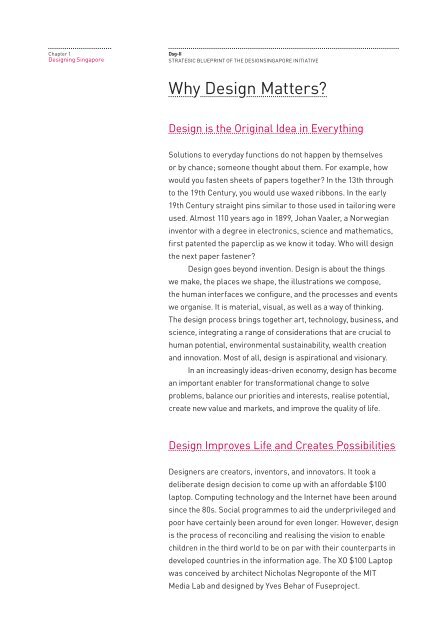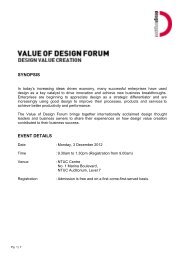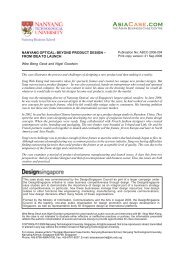Dsg-II - DesignSingapore Council
Dsg-II - DesignSingapore Council
Dsg-II - DesignSingapore Council
You also want an ePaper? Increase the reach of your titles
YUMPU automatically turns print PDFs into web optimized ePapers that Google loves.
Chapter 1<br />
Designing Singapore<br />
<strong>Dsg</strong>-<strong>II</strong><br />
STRATEGIC BLUEPRINT OF THE DESIGNSINGAPORE INITIATIVE<br />
Why Design Matters?<br />
Design is the Original Idea in Everything<br />
Solutions to everyday functions do not happen by themselves<br />
or by chance; someone thought about them. For example, how<br />
would you fasten sheets of papers together? In the 13th through<br />
to the 19th Century, you would use waxed ribbons. In the early<br />
19th Century straight pins similar to those used in tailoring were<br />
used. Almost 110 years ago in 1899, Johan Vaaler, a Norwegian<br />
inventor with a degree in electronics, science and mathematics,<br />
first patented the paperclip as we know it today. Who will design<br />
the next paper fastener?<br />
Design goes beyond invention. Design is about the things<br />
we make, the places we shape, the illustrations we compose,<br />
the human interfaces we configure, and the processes and events<br />
we organise. It is material, visual, as well as a way of thinking.<br />
The design process brings together art, technology, business, and<br />
science, integrating a range of considerations that are crucial to<br />
human potential, environmental sustainability, wealth creation<br />
and innovation. Most of all, design is aspirational and visionary.<br />
In an increasingly ideas-driven economy, design has become<br />
an important enabler for transformational change to solve<br />
problems, balance our priorities and interests, realise potential,<br />
create new value and markets, and improve the quality of life.<br />
Design Improves Life and Creates Possibilities<br />
Designers are creators, inventors, and innovators. It took a<br />
deliberate design decision to come up with an affordable $100<br />
laptop. Computing technology and the Internet have been around<br />
since the 80s. Social programmes to aid the underprivileged and<br />
poor have certainly been around for even longer. However, design<br />
is the process of reconciling and realising the vision to enable<br />
children in the third world to be on par with their counterparts in<br />
developed countries in the information age. The XO $100 Laptop<br />
was conceived by architect Nicholas Negroponte of the MIT<br />
Media Lab and designed by Yves Behar of Fuseproject.





